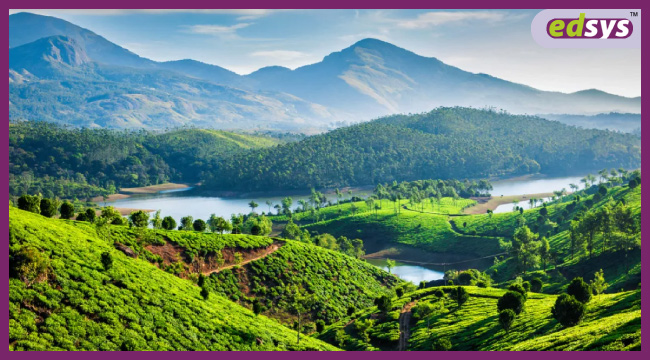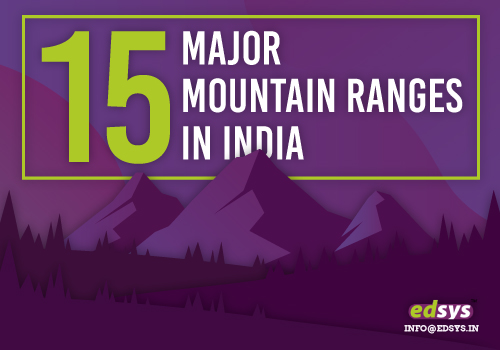15 Major Mountain Ranges in India: Oldest and Longest Mountain ranges in India

India and its Mountain ranges
India is a land of huge natural diversity. From snow-capped mountains to dry deserts and sandy coastlines, the natural landscape is as diverse as the culture and tradition of the nation.
There are many mountain ranges in India, including the longest and oldest mountain ranges in the world.
All these mountain ranges in India have a profound impact on the weather conditions, lifestyle, religious beliefs, and economic development of the country.
In this blog, we will explore the 15 major mountain ranges in India.
| Sl no | List of Mountain Ranges in India |
| 1 | The Himalayan Mountain Range |
| 2 | The Western Ghats |
| 3 | The Eastern Ghats |
| 4 | The Aravalli Mountain Range |
| 5 | The Karakoram and Pir Panjal Mountain Range |
| 6 | The Purvanchal Mountain Range |
| 7 | The Satpura and Vindhya Mountain Ranges |
| 8 | Zabarwan Range |
| 9 | Eastern Himalaya |
| 10 | Western Himalaya |
| 11 | Pachaimalai Hills |
| 12 | Kudremukh |
| 13 | Sivalik Hills |
| 14 | Kaimur Range |
| 15 | Lower Himalayan Range |
1) The Himalayan Mountain Range
Best season to visit-Winter (December until Early-March)
How to get there – View Direction
The Himalayan Mountain Ranges is 2,400 kilometers long and traverses through five countries – India, Nepal, Tibet, Bhutan, and Pakistan.
It begins near the Indus River in Pakistan and ends near the Brahmaputra River in India.
The Himalayan states of India are Sikkim, Arunachal Pradesh, Himachal Pradesh, Uttarakhand, and Jammu and Kashmir.
When you look at the top view of this mountain range from space, it looks like an arch.

In terms of age, the Himalayas is quite a young mountain range as it was formed around 40 to 50 million years ago.
The word “Himalayas” is derived from Sanskrit and means “The Land of Snow.”
This huge mountain range consists of three parallel ranges, which are known as the Outer Himalayas (Shivalik range), the Greater Himalayas, and the Lesser Himalayas.
The Kali Gandaki Gorge is located at around 8000 kilometers distance from the start of the range. This gorge divides the mountain range into the Eastern and Western sections.
The world’s highest peak – Mount Everest as well as three of the six highest peaks of the world is in the east of the Himalayas, in the Mahalangur Himal region.
The other three peaks are Cho Oyu, Lhotse, and Makalu.
It is believed that the Himalayas have more than 1500 glaciers and hundreds of lakes that form the biggest source of freshwater for the Himalayan nations.
The rivers that originate in this mountain range are Ganges, Indus, Saraswathi, Yamuna, Yangtze, Ganga-Brahmaputra, Yarlung, and Nujiang.
2) The Western Ghats

Best season to visit-After October
How to get there: View Direction
The Western Ghats is 1600 kilometers long, and extends from Gujarat to Tamilnadu, traveling through Maharashtra, Goa, Karnataka, and Kerala.
Geographical evidence shows that these mountain ranges are older than the Himalayas.
The Western Ghats are believed to have been formed about 150 million years ago.
These mountain ranges have been declared as UNESCO World Heritage Site for their biodiversity.
These Ghats are home to 7402 species of flowering plants, 6000 species of insects, 1814 species of non-flowering plants, 508 species of birds, 179 species of amphibians, 290 species of freshwater fishes, and 139 species of mammals.
Of these 325 species are in globally threatened status. There are 39 wildlife sanctuaries and national parks in the Western Ghats region.
The Western Ghats are not just protected for their biodiversity, but also because of their strategic influence on the monsoon rains.
These huge mountains act as a barrier to the south-west monsoon winds and divert the rain-laden winds towards the Indian subcontinent.
The major rivers that originate from the Western Ghats are Cauvery, Godavari, Krishna, Tungabadra, and Tamirabarani.
3) The Eastern Ghats

Best season to visit-Between October and March
How to get there: View Direction
The Eastern Ghats start from Odissa in the North and travel down to Tamilnadu, parallel to the Bay of Bengal. They pass through certain areas in Karnataka, Kerala, and Andhra Pradesh.
Unlike the Western Ghats, the Eastern Ghats are not a continuous mountain range.
Rivers flowing through the range have eroded the mountains creating huge gaps between stretches of undulating hills.
The four major rivers that flow through the Eastern Ghats are Cauvery, Godavari, Mahanadi, and Krishna. The rivers that originate in the Eastern Ghats are Rushikulya, Vamsadhara, Sarada, Sabari, Nagavalli, Palar, Champavathi, Gosthani, Sileru, Tammileru, Pennai, Swarnamukhi, Penna, Gundlakamma, Kundu, and Vellar.
This discontinuous mountain range is called by different names in different parts. In Odissa, these stretches are known as the Chandragiri-Pottangi mountain system and Garhjat Hills.
In Tamilnadu, these discontinuous stretches are known as Karanthamalai Hills, Sirumalai Hills, Pachamalai, Kollimalai, Kalrayan hills, Palani hills, Mettur hills, Servarayan hills, Javadhu Hills, and Shevaroy Hills.
Also Read: Top 12 Longest and Major Rivers in India
The Biligiriranga Hills and the Nilgiris Hills form the corridor between the Eastern and Western Ghats. In Karnataka, the mountain stretches are known as Male Mahadeshwara Hills.
In Andhra, they are known as the Seshachalam-Velikonda Range, Palikonda-Lankamalla-Nallamala Ranges, Kondapalli Hills, Papi Hills, Maliya Range, and Madugula Konda range.
4. The Aravalli Mountain Range

Best season to visit-November to February
How to get there- View Direction
The Aravalli Mountain ranges are one of the oldest ranges in the world. Geologists believe that these fold mountains existed even when the Indian subcontinent separated from the Eurasian plate.
Archeological excavations have found Harappa and Indus Valley Civilization sites in these mountain ranges.
The Aravalli Range extends from Delhi and travels in the south-western direction toward Gujarat, passing through South Haryana and Rajasthan.
A major portion of this mountain range lies in Rajasthan. Some parts of this mountain range contain thick forests and in other places have only sand and stone.
These mountains are a rich source of minerals such as rock phosphate, asbestos, talc, apatite, beryl, kyanite, lead, silver, and zinc.

The rich mineral deposits have to lead to excessive mining in this mountain region. Many naturalists are lobbying for the protection of these oldest fold mountains to prevent them from becoming completely destroyed.
These mountain ranges are the natural habitat of many flora and fauna. Plus, they create a natural barrier between eastern Rajasthan and the Thar Desert. The rivers that originate in the Aravalli hills are Sabarmati, Luni, Sakhi, Sahibi, and Banas.
5) The Karakoram and Pir Panjal Mountain Range

Best season to visit-March to August
How to get there: View on Map
These mountain ranges lie to the south and north-west of the Himalayas. A major part of the Karakoram Range lies in the disputed region between India and Pakistan.
This mountain range also passes through Jammu and Kashmir and Himachal Pradesh. Actually, the Pir Panjal range is a part of the Lesser Himalayas Mountain Range.
These mountains start from the Himalayas and separate from the range near the River Sutlej. From there, this range travels separately with Ravi and Beas rivers on one side and the Chenab River on the other side.
This mountain range boasts of the largest glacier outside the poles – The Siachen Glacier. The second highest peak in India and the third highest peak in the world – K2 is also in this mountain range.
There are many passes and tunnels in this mountain range. The Haji Pir Pass located in the western part of this mountain range connects Poonch and Uri.
The other passes are Rohtang Pass, Sinthan Pass, Banihall Pass, and Pir Panjal Pass.
Tunnels such as Jawahar Tunnel, Banihal Qazigund Road Tunnel, Atal Tunnel, and Banihal Railway Tunnel have improved accessibility to the villages and towns nestled in the Karakoram and Pir Panjal mountain range.
6. The Purvanchal Mountain Range

Best season to visit-Monsoon Season
How to get there – View Directions
The Purvanchal mountain range extends from the Himalayas toward the northeastern region of India, south of the Brahmaputra valley.
It travels through Arunachal Pradesh, Assam, Manipur, Tripura, Meghalaya, Mizoram, and Nagaland.
The hills in this mountain range are Kohima, Patkai, Barail, Khasi–Jaintia, Naga Hills, Lushai, Manipur, and Mizoram Mizo. This mountain range has the wettest place on earth – Cherrapunji.
7. The Satpura and Vindhya Mountain Ranges

Best season to visit-October and February
How to get there- View Direction
The Satpura and the Vindya are parallel mountain ranges that pass through the central part of the country.
Also Read: 24 Most Popular National Festivals Of India
The Satpura mountain range is triangle shaped. The tip of the triangle is at Ratnapuri and the other two sides run parallel to the Tapti and Narmada Rivers that drain into the Arabian Sea.
This mountain range travels through Gujarat, Madhya Pradesh, Chhattisgarh, and Maharashtra.

The Vindhya mountain range is one of the oldest mountain ranges in India and is a discontinuous range of mountains. It travels from East to West through Madhya Pradesh and Gujarat.
The Vindhya hills near Champaneer end in a series of hills, which connect this mountain range with the Aravalli mountain range.
Tributaries of Ganga and Yamuna flow into the Vindhya mountain ranges. The tributaries are Ken, Chambal, Betwa, Kali Sindh, Parbati, and Dhasan.
8) Zabarwan Range

How to get there- Direction
Best season to visit- March to August
The Zabarwan Range is situated between Pir Panjal and Great Himalayan Range. It comes in the central part of the Kashmir valley in the union territory of Jammu and Kashmir.
The north part of Zabarwan range lies in Ganderbal and the south end lies in Pampore.
Madhav peak is the highest peak of this range.
This mountain range possesses rich wildlife and is a home to animals including jackal, leopard cat, musk deer, Himalayan brown bear, red fox, langur, Himalayan weasel, long-tailed marmot, serow, Indian porcupine etc.
9) Eastern Himalaya

Best season to visit: Late October until early May
How to get there: View Direction
The Eastern Himalayas comprise the tracts of the Darjeeling Hills of North Bengal, eastern Bhutan, Arunachal Pradesh, and Sikkim.
The Eastern Himalayas can be divided into different climatic regions such as subtropical, sub-arctic, artic, and temperate.
The forests here are evergreen, semi-evergreen, moist, dense, or temperate. The subtropical forests cover the hills to an extent of about 2000m.
This place is home to a huge diversity of animals including clouded leopard, slow loris, the Indian civet, the golden languor, the golden cat, rhinoceros, etc.
Besides, it is also home to birds such as the snowcock, heron, the white-winged wood duck, and more.
[“source=edsys”]




